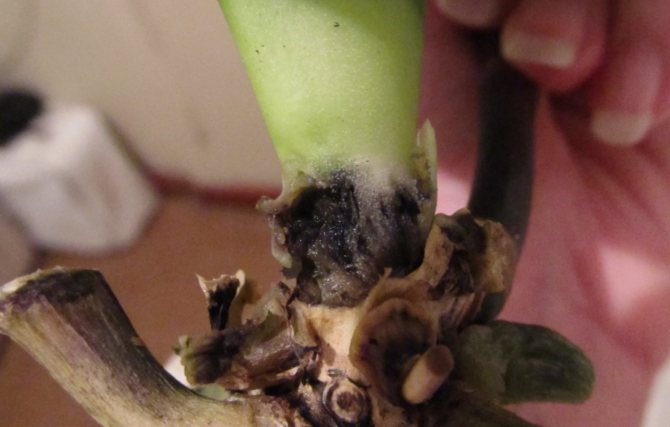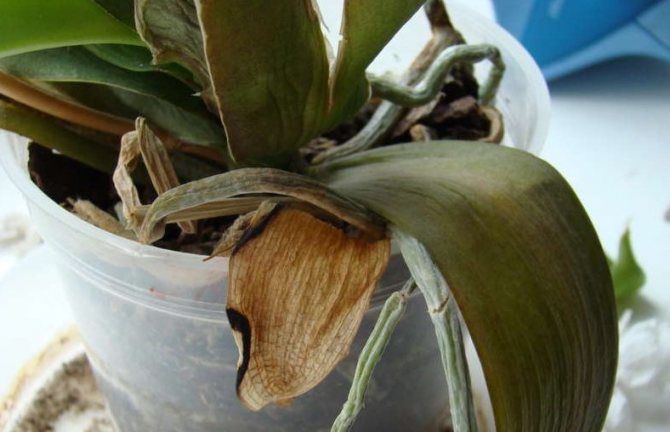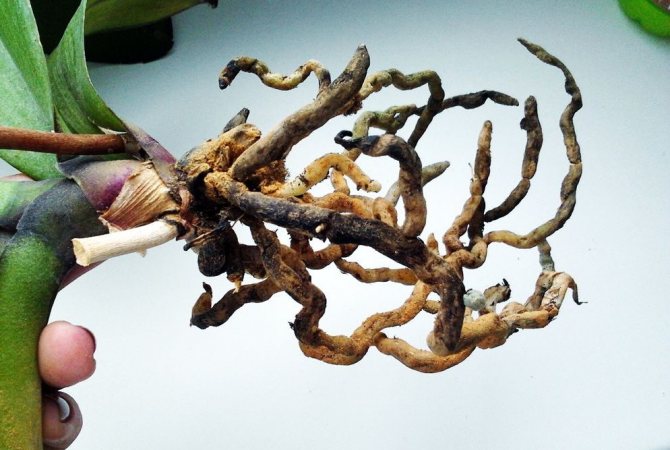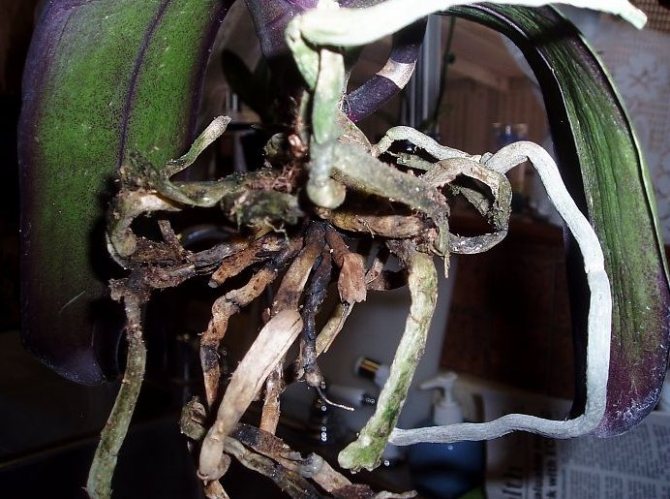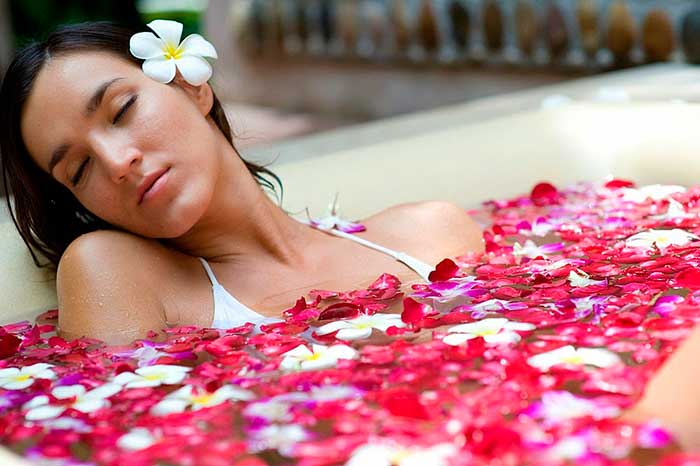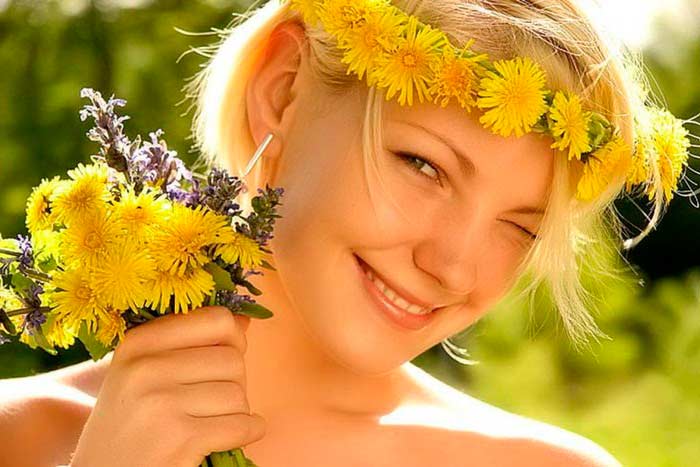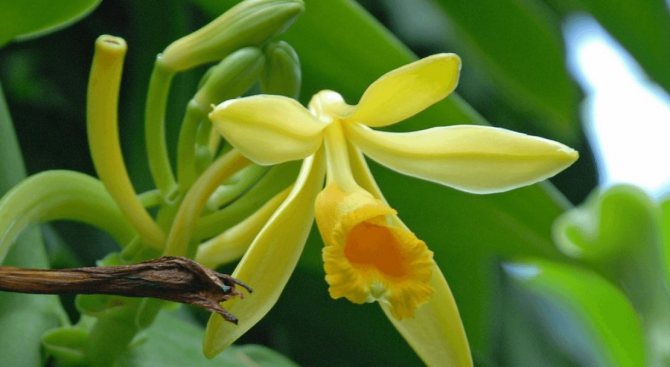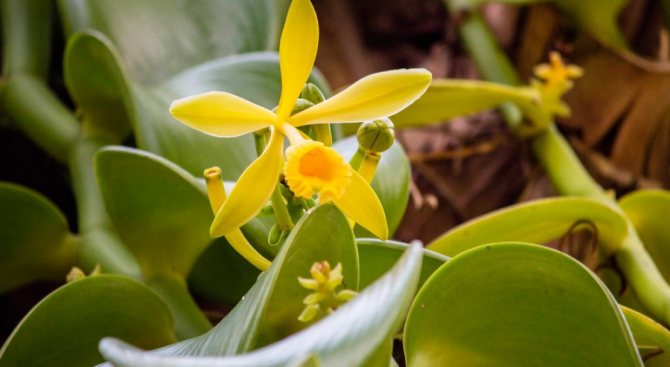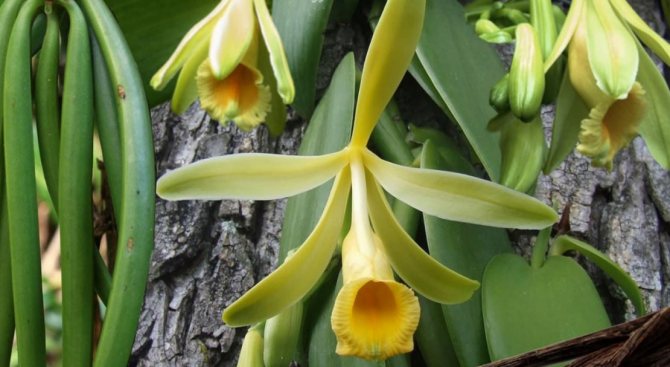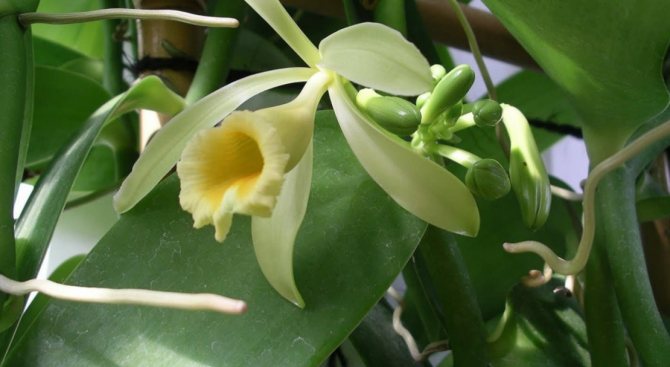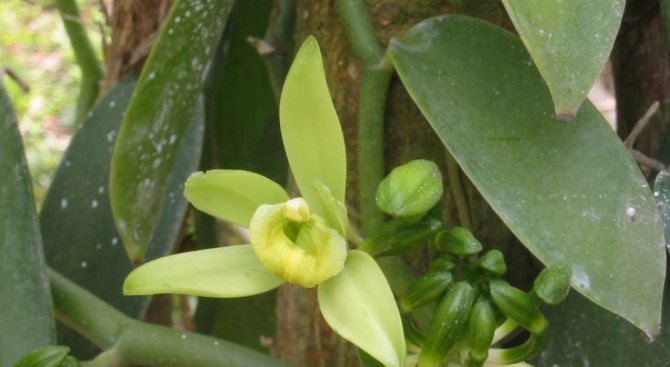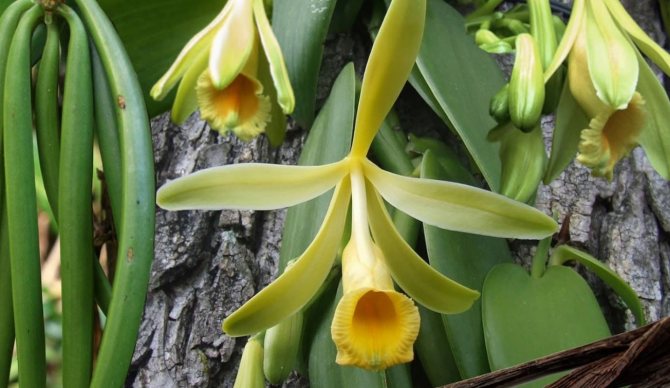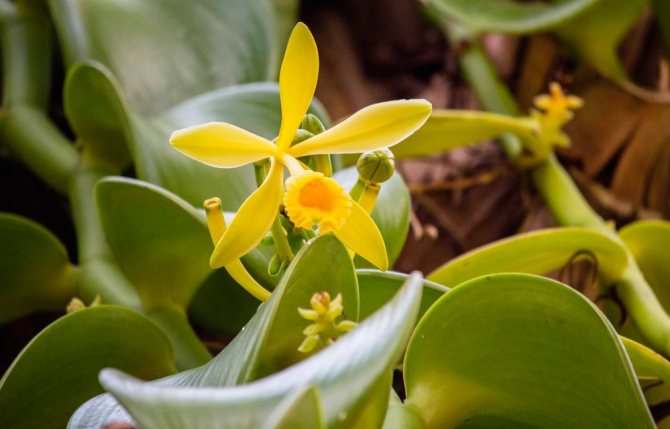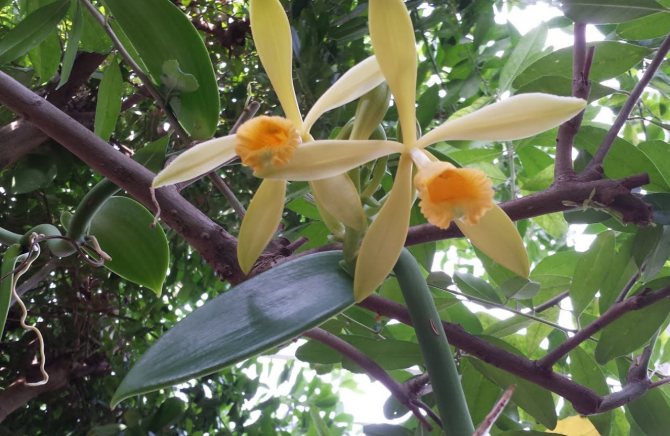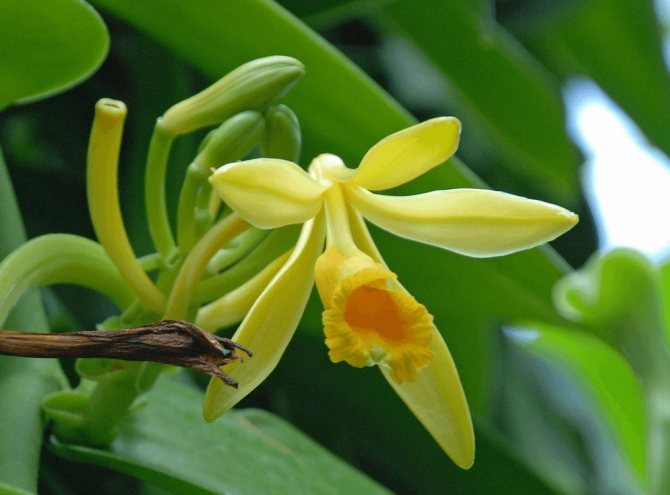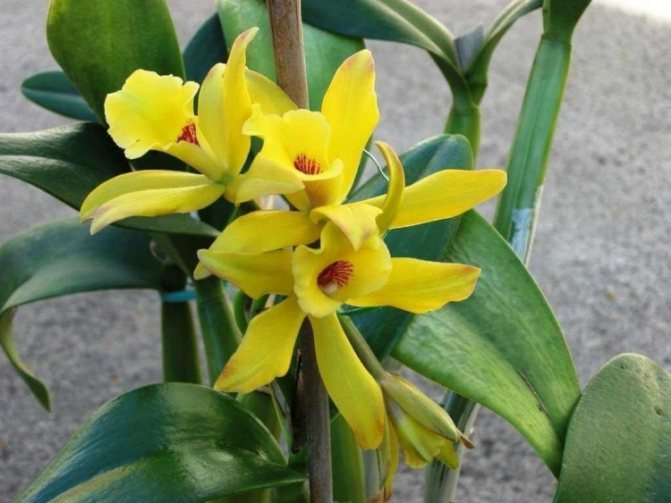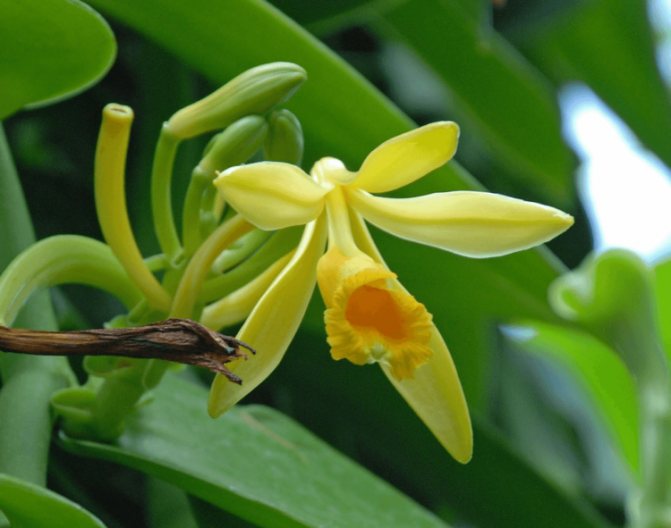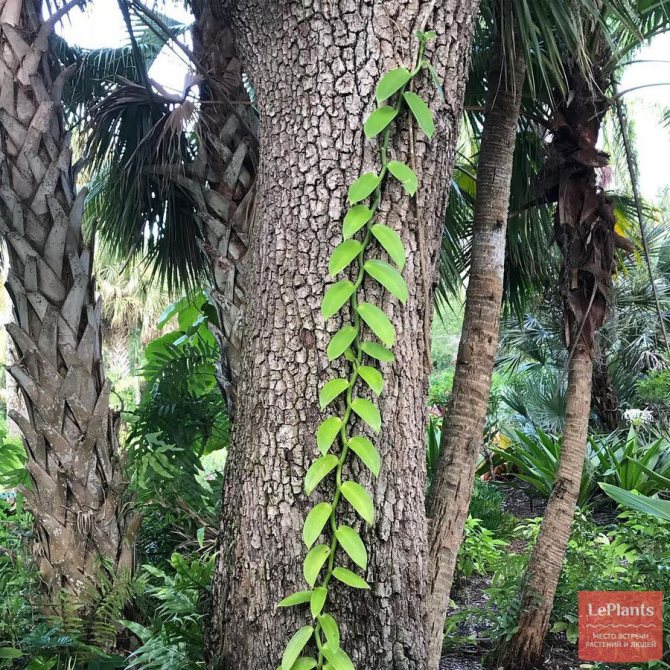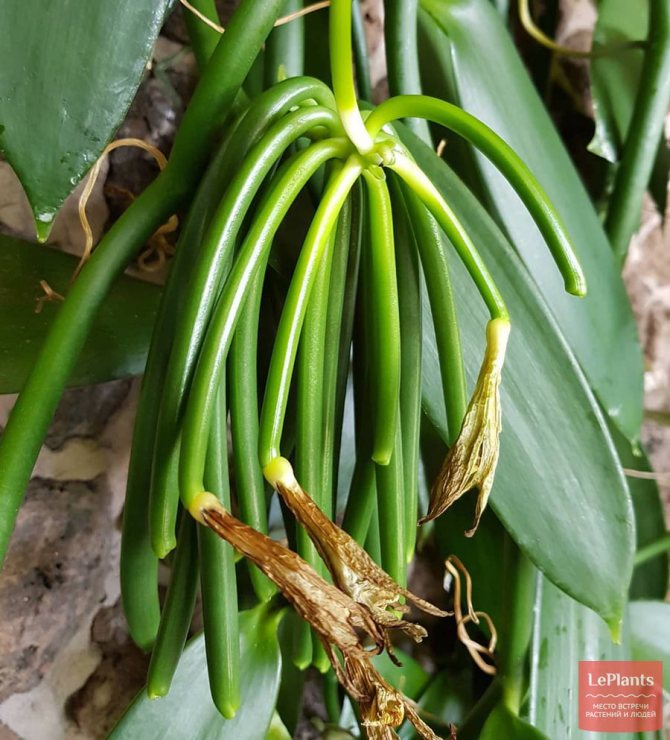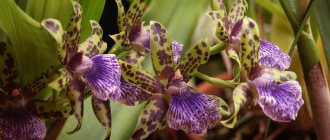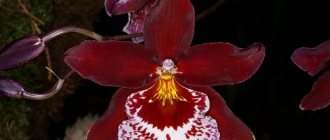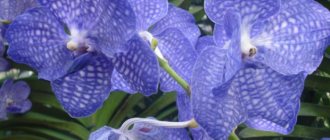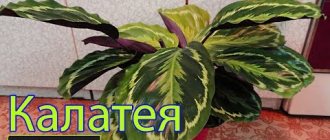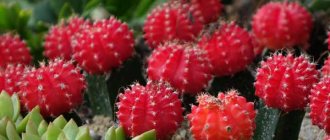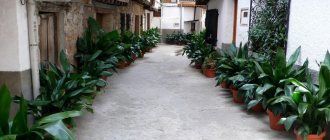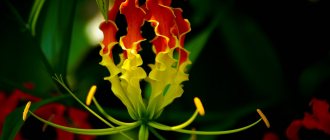0
Blooming orchids leave no one indifferent. There are those who just look and admire the bright flowers of different colors and sizes. There are those who do not always successfully try to grow a beautiful flower in a room on their own. And there are those who have managed to tame beautiful plants and surround themselves with bright flowers. We will try to find out more about them, because some have found application in human economic activity, not only as beautiful flowers.
The flat-leaved orchid or vanilla orchid has been used by the indigenous population as a valuable medicinal plant since ancient times, and vanilla pods had the power of money. Now this plant is grown for the aromatic vanilla seasoning.
We will try to find out more about this plant, and whether it is possible to grow a vanilla orchid on our own in indoor conditions.
Brief general information
Vanilla is a vine orchid. The homeland of the flower is the Antilles, Panama and Mexico. Currently, this plant is grown all over the world not only for obtaining a popular spice from it, but also as an ornamental plant, the flowers of which exude a rather delicate vanilla aroma. This is a plant from the seeds of which the well-known spice is produced - vanilla. The genus Vanilla includes more than 100 representatives, mostly called epiphytic or terrestrial.
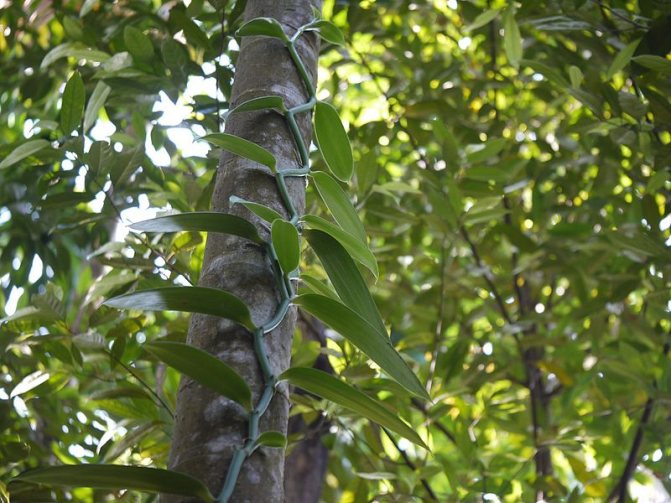
For the production of extracts and spices, which are used in the perfumery industry, only a few varieties of vanilla that exist in nature are used. Vanilla planifolia is widely used in cosmetology. It should be noted that only an ornamental plant with flowers with a pleasant aroma can be grown at home, but for this it is necessary to recreate conditions close to natural.
What is the difference from other species?
The main difference between vanilla orchid and other types of orchids is the scale of stem growth. This variety is a liana - a tenacious, highly climbing plant - a perennial. Also, some varieties of this species are grown specifically for the production of spices. For example, flat-leaved vanilla grows not only in the forests of Mexico and Panama, but is also actively cultivated in Madagascar and the Seychelles.
Vanilla orchid is a vine that stores water in its stems.like many representatives of succulents.
Vanilla orchid gives incredible growth in one year with proper care. The stems grow 50 - 100 cm.
Description
Vanilla orchid has large greenish-white or yellow-green flowers that open only during the day for pollination by hummingbirds or bees. It should be noted that in some countries the pollination process is done manually.
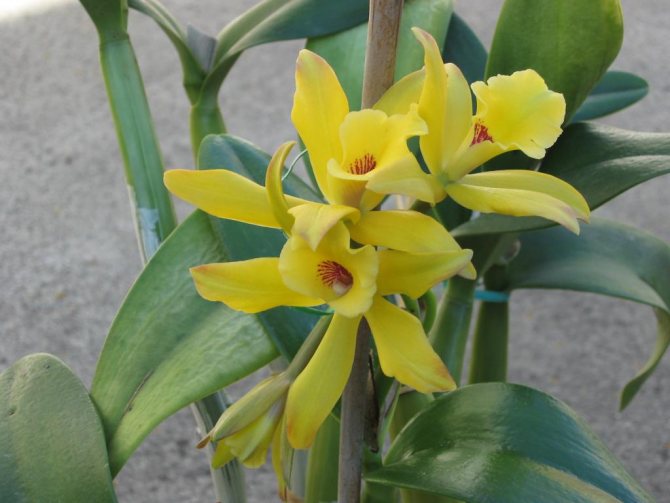

Elongated leathery orchid leaves have a dark green tint. The peculiarity of vanilla is that on the plant, along the entire shoot, there are aerial roots, with which it is attached to the trees during the growth process.
Chemical composition, calorie content
What is the calorie content of vanilla? 100 g of the spice contains 288 kcal.
It has a rich chemical composition:
- mineral salts, easily digestible carbohydrates;
- vitamins - PP, thiamine, riboflavin, B5, B6;
- macronutrients - first of all, potassium, as well as magnesium, calcium, sodium, phosphorus;
- trace elements - iron, zinc, copper, manganese;
- omega fatty acids.
Vanilla contains essential oils, tannins, glycoside glucovanillin, which is converted into vanillin and glucose during fermentation.
Landing
In which land should vanilla orchid be planted? Pine bark should be a part of the substrate. For this representative of Orchids, the composition of the soil is slightly different from the usual one intended for all plants of the epiphytic family. For its preparation, the following components are required: sphagnum moss, tree bark and charcoal, perlite or fern roots, peat in a small amount. In general, the substrate should be rich, breathable and lightweight.
The vanilla should be planted in a clay or plastic container (pot), and you can also use an orchid basket. The latter is most often used, since the holes prevent moisture stagnation in the soil and make it possible for the roots to breathe better. It is important that the size of the container is slightly larger than the volume of the root system (the distance to the walls of the container should be approximately 2-3 cm).
How are vanilla pods obtained?
The vanilla fruits themselves, which are harvested unripe, have no aroma. It is formed in the process of long correct preparation.
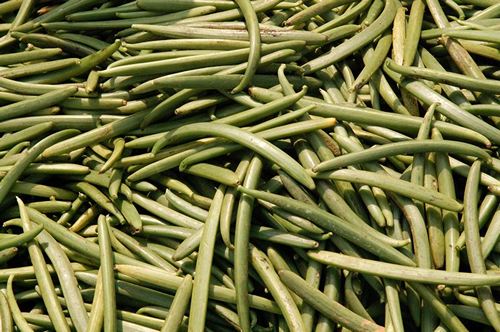

Unripe fruits
What is the spice made of? The collected creeper pods undergo painstaking processing:
- they are briefly placed in hot water;
- then removed and left to dry and ferment in the fresh air - at least a week. The pods are wrapped in blankets and kept under the sun for a certain time, increasing it every day;
- the next stage is drying the fruits in the shade (up to several months), until the pod is covered with a bloom of thin white crystals of vanillin. Its total spice composition is not more than 3%, but it is to him that vanilla owes its wonderful smell;
- ripe pods are sorted and sent to the warehouse for packaging.
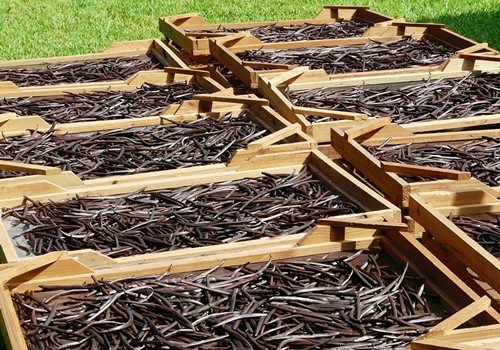

Ready-to-eat vanilla
Important! What quality the vanilla will end up with depends on the type of liana from which the fruits are collected, and on the observance of the cooking technology. During this process, the raw material loses up to 2/3 of its weight, but acquires a unique aroma.
Conditions for growth
Vanilla orchid is a light-loving plant, but direct sunlight is contraindicated for it. He needs bright, but slightly diffused lighting throughout the day. In the winter season, it is advisable for the plant to provide artificial lighting.
This species of the family is very thermophilic. Throughout the year, the temperature should not change much (during the day - + 28-29 degrees, at night - not lower than + 20-23 degrees). Older plants can tolerate a temperature drop of about 3-4 degrees.


Due to the tropical origin of the plant, the air humidity (80-90%) should be constantly maintained. To do this, the orchid must be regularly sprayed or a container with wet expanded clay should be placed on a pallet.
Temperature
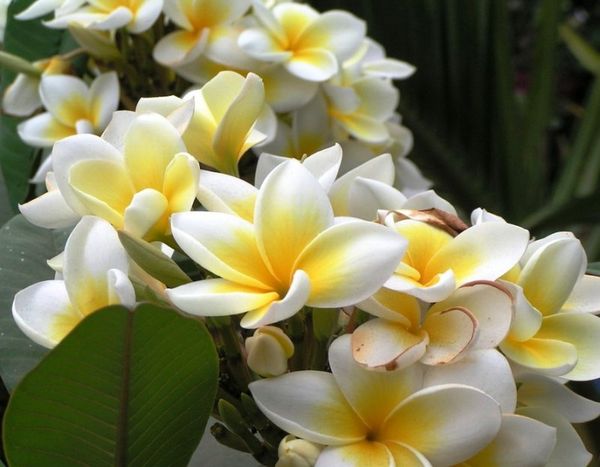

What are the rules for growing such a beauty on your own windowsill? A piece of liana planted in a pot of a suitable size with a mixture of perlite, pine bark, leafy earth and coconut fiber should develop in the summer at a temperature of about 28-30 degrees Celsius. At night, the indicators must be lowered to 25-26 degrees. As for the winter period, the recommended temperature regime is + 20 degrees.
Care
The vanilla orchid is a climbing plant, so a strong support is needed to grow it. Suitable for this is a tube covered with coconut fiber or a standard climbing plant. You can also use a hanging planter.
Watering is carried out in case of complete drying of the top layer of the soil, but it is impossible to allow the entire volume of the substrate to dry out. It is best to use warm, purified, calcium-free water. In addition to watering, a warm shower is important for the orchid (about once a week). Watering can also be done by immersion.It should be significantly reduced during the period of decreased growth activity and during the dormant period of the plant, but in no case should the substrate be allowed to dry out.
Vanilla takes fertilizers very well. Throughout the year (2-3 times), fertilizing with special fertilizers intended for orchids is useful for the flower. It should only be remembered that the concentration of the mixture should be reduced by 2-3 times in comparison with the dosage indicated on the package. Top dressing can also be carried out by spraying.
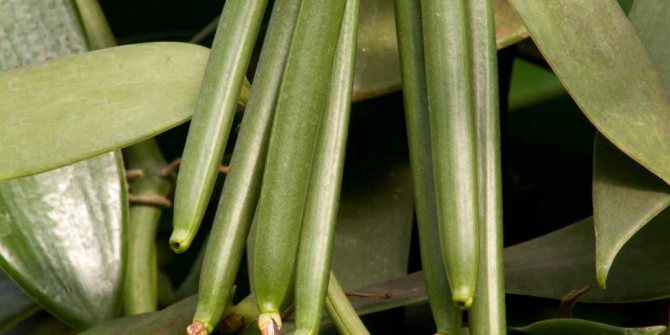

The benefits and harms of vanilla
The benefits of using vanilla are much greater than the harmful effects. Although it is worth knowing about the negative effects of this spice, about contraindications to its use.
Beneficial features
Why the spice is useful:
- has a positive effect on the nervous system – has a sedative, relaxing effect, improves mood;
- normalizes the digestive process, regulates appetite, improves metabolism;
- has a beneficial effect on the skin - relieves acne, whitens, makes it more elastic;
- helps in the prevention of diabetes, hormonal problems;
- improves well-being during menstruation;
- plays the role of a strong aphrodisiac.
Harm and contraindications
The harmful effects of vanilla are that the spice can:
- cause allergic reactions;
- increase susceptibility to ultraviolet rays - after using vanilla essential oil, it is undesirable to be in the sun;
- intoxicate with a specific aroma.
It is contraindicated to use the spice:
- people with individual intolerance;
- women during pregnancy and breastfeeding;
- children.
Transfer
Usually, the vanilla orchid is transplanted in order to replace the soil or in cases where the roots in the pot no longer fit (in 2-3 years, once). The best time is spring.
The plant must be carefully removed from the old container without damaging the root system. To avoid the formation of rot on some of the broken roots, it is necessary to sprinkle them with ground charcoal. It should also be noted that the new capacity should be larger than the previous one, though not much.
At first, the transplanted plant in watering should be slightly limited, the dose of sunlight should be increased gradually.
How to choose an orchid when buying?
In order not to throw money down the drain, when buying Vanilla, follow the rules:
- Inspect the flower and where it stands in the store.
- Do not use a sluggish, damaged plant that has spots or plaque on its leaves.
- Refuse to buy if the orchid grows in dry or waterlogged soil, there is water in the pan.
- If possible, study the roots: a gray or brown color indicates poor care and disease, a light green or purple tint indicates health. There should be more roots than the soil in the pot.


Plant propagation methods
Are vanilla orchid seeds good for planting? It's important to note that store-bought vanilla bean pods are not viable at all. They have undergone thermal processing, and therefore are only suitable for use in cooking. Viable seeds can be found commercially, but a florarium (plant terrarium) is needed to obtain viable seedlings.
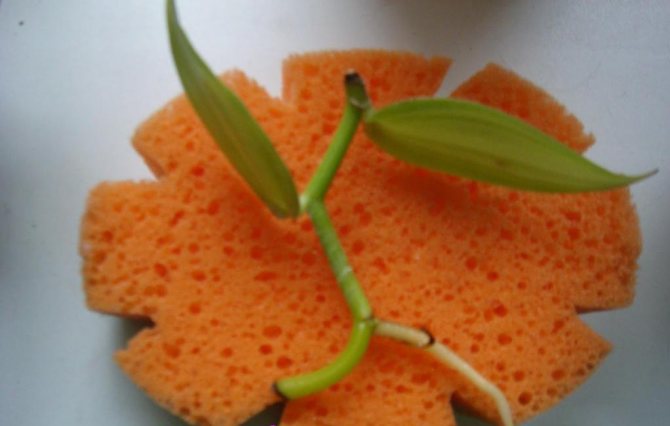

A simpler and more acceptable way to propagate a vanilla orchid is by cuttings. To do this, you need to pick up that part of the shoot where there are at least three nodules with aerial roots.
The stalk must be treated with a growth stimulant (for example, heteroauxin). Next, the offshoot must be placed in a container with moistened soil (preferably with sand), covered with polyethylene, creating greenhouse conditions. Periodically, you need to ventilate the sprouts by opening the greenhouse. When the seedling begins to grow noticeably, the film should be completely removed. After the appearance of the first 3 leaves, the plant must be transplanted into a prepared substrate.The container must be plastic and transparent, always with drainage holes. As noted above, the vanilla orchid is a vine that needs support. It is also necessary to provide it with a small sprout.


Bloom
When and how?
Under natural conditions, the vanilla orchid blooms after 3 years. Inflorescences are large, unite up to 10 flowers. The flowers are yellow with a greenish tint.
Reference! Fragrant flowers in their homeland attract exotic birds and bees, they also pollinate the flower in a natural way. In production, pollination is carried out artificially.
Seed pods ripen six months later.
Care before and after flowering
The heat-loving vanilla orchid loves moisture and a warm climate all year round.... In autumn and winter, you should use additional illumination with special lamps. After flowering, the orchid should be prepared for rest - reduce the temperature, reduce feeding and watering.
What if the buds do not appear?
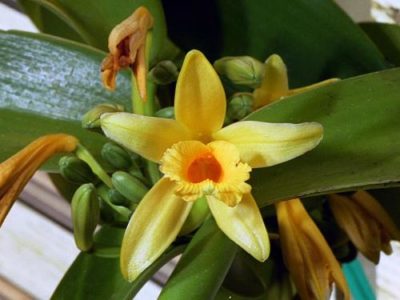

In home floriculture, the Vanilla orchid rarely blooms. The decorativeness of the flower is made up of creeping stems, bright leaves.
- For flowering, you should increase the humidity of the air, add daily spraying.
- A daily difference of several degrees is also required. The air temperature should not fall below 20 ° C.
- From a lack of light, buds are not formed. For abundant flowering, full-fledged lighting is necessary.
- The potting mix may not be suitable for the vine; heavy soil inhibits flowering.
Plant pruning
This procedure is extremely necessary for an orchid. It should be carried out regularly, since it is impossible to grow this plant to its full length at home. In addition, the orchid rejuvenates due to pruning, and it has new side shoots, which gives it splendor and forms a compact shape.
For such a procedure, the instrument used must be disinfected. Shoot slices should be sprinkled with activated charcoal or some other preparation. The tops of the pruned vine can be used for breeding.
Soil, planting and transplanting vanilla orchids at home
Block (bark) and soil for vanilla orchid:
For cultivation, only special soil mixtures for orchids are used, to which a little soil for decorative flowering plants is added. For a vanilla orchid, the bark of a small fraction is more suitable, therefore, especially large pieces should be broken. If special soil for orchids is not available at the flower shop, you can make it yourself by mixing pine bark, high peat and adding more charcoal and sphagnum moss. The soil for the orchid vine should be well breathable and moisture permeable.
Correct transplant of vanilla orchid:
The orchid reacts extremely negatively to the transplant, its growth may even slow down after this procedure, so it should only be disturbed as a last resort, for example, if the substrate is heavily crushed, stopped in dust, or the plant has become very cramped in the pot. The transplant is carried out only in the spring.
The vine orchid pot should be low and wide. A couple of heavy stones are placed on the bottom, for stability, then a thick layer of drainage and a layer of fresh soil are poured, and only then they transfer the orchid itself, filling all the voids with a new substrate.
Consider that the orchid must be taken carefully, trying not to damage the roots. If this happens, the damaged roots should be sprinkled with crushed charcoal or activated carbon.


Vanilla pompona.
Diseases and pests of orchids
Vanilla orchid is almost not damaged by pests, and diseases can arise either due to an excess of moisture, or, conversely, due to overdrying.
- With excess moisture, root or stem rot can develop. It is necessary to immediately transplant the flower, replacing the entire substrate in the container, and reduce watering.
- Insufficient watering can lead to dry leaves. In this case, it is necessary to moisten the soil more often and spray it.
- Light spots may appear on the leaves (which means that direct sunlight falls on the plant). In this case, light shading should be provided at noon.
- With excessive feeding, the air roots of the orchid may turn black.
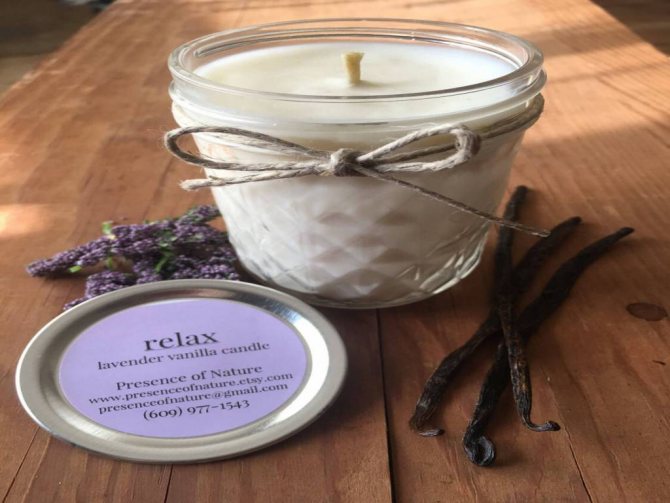

Application area
A spice with a wonderful aroma and a rich spectrum of useful effects has found its application in various spheres of our life - cosmetology, medicine, cooking. The beneficial qualities of vanilla are successfully used everywhere.
Cooking
Pod vanilla is a spice, without which many dishes would not have such a unique taste, and, most importantly, aroma.
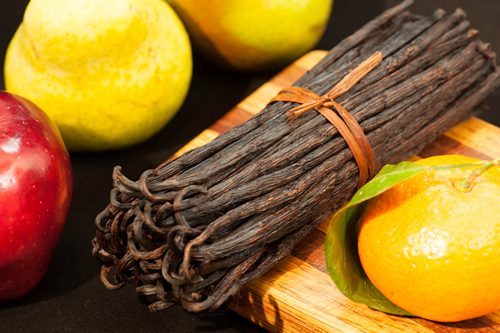

The natural spice is far from cheap, so it is used more often in the menus of respectable restaurants and expensive cafes. In the confectionery industry, cheaper analogs of vanilla are preferred.
The famous Guryev porridge today is a real delicacy. And it turns out that it cannot be fully prepared without the use of aromatic seasoning.
Where are vanilla pods added?
The natural spice is used mainly for flavoring top quality confectionery products:
- exclusive chocolate;
- fillings for expensive sweets;
- nut and Christmas cookies;
- creams for gourmet cakes;
- premium alcoholic beverages.
If the price of the issue does not matter, then there are a lot of options for how to use the pod:
- for flavoring ice cream;
- as an important flavoring component of biscuits, puddings, soufflés;
- as an additive to dairy products - yoghurts, cream, curd spreads;
- in the manufacture of drinks - liqueurs, coca-cola, cocktails.
The confectionery industry uses vanillin more often as a more affordable additive to products:
- jelly, mousse;
- jams, preserves;
- compotes, fruit drinks;
- glaze, syrups.
Vanilla is flavored not only by sweets - if you mix spice seeds with olive oil, then the resulting substance will favorably set off the taste of dishes from meat, poultry, seafood, sauces.
Dosage
Have you always believed that a spice with a sweet aroma should taste the same? In the case of vanilla, everything is different - it is bitter. Therefore, it is so important to observe the exact dosage in order to enrich the taste of the dish, and not spoil it.
The correct proportions are as follows:
- a quarter of a vanilla stick will go to 1 kilogram of product;
- 1/20 of the pod is enough for 1 serving.
Vanilla sugar for dough or sprinkling on a finished dish is done as follows: powdered sugar (0.5 kg) is ground with 1 spice pod.
What is the dosage of vanilla essence? For 6 servings of the dish, 3 drops are enough.
How to use a vanilla pod correctly?
To prepare desserts, including vanilla cream, you need to cut the spice pod, separate the seeds and boil it in milk or cream.
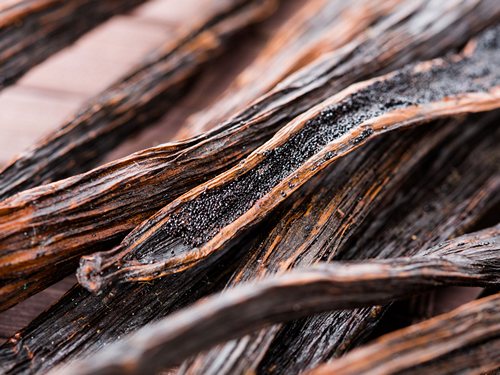

Cut pod
The vanilla extract is prepared by pouring the cut into pieces the pod with alcohol (30 ml is enough). You need to insist at least 3 weeks.
Vanilla seeds are most commonly used in cooking. The pod itself can be placed in a sugar bowl to add a special flavor to the sweet substance.


Vanillin in sugar bowls
Placing the pods in a container and pouring the sugar syrup into a bowl creates vanilla syrup. Insist on it for about 2 weeks, and store up to six months.
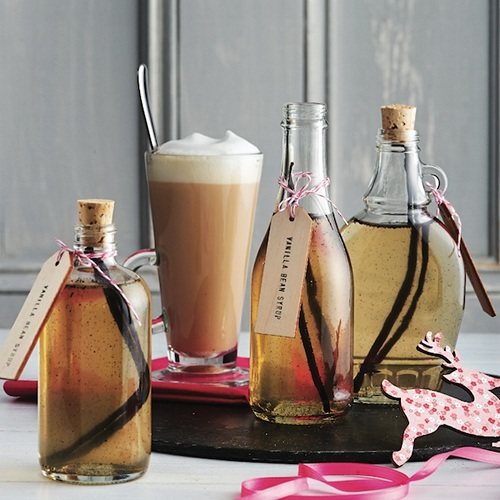

Vanilla syrup
How to replace the pod?
Since the vanilla pod is a spice, not everyone can afford to use it often.
Therefore, vanillin, an artificially synthesized product, is actively used in cooking. There are certainly bags with such confectionery seasoning in every home.
What else can you replace the vanilla pod with:
- Vanilla extract - small spice pods infused in an alcohol solution.
- Essence - a more concentrated infusion of vanilla.
- Vanilla powder - crushed plant pods.
- Vanilla sugar - natural (the pods are covered with sugar and, tightly closed, insist for 7 - 10 days) and artificial (sugar is mixed with vanilla).
Cosmetology
The beauty industry has found use of the beneficial properties of vanilla in decorative cosmetics - the spice is included in creams and hair products. And also the aroma of vanilla is loved by perfumers.
Cosmetology develops products based on vanilla extract and essential oil.
Cosmetic preparations with vanilla have a beneficial effect on the skin:
- whiten and remove pigmentation;
- reduce irritation, soothe;
- help moisturize and soften;
- tone up, making the skin more elastic;
- counteract the harmful effects of the environment.
Vanilla creams belong to the line of expensive cosmetics.
Spice as one of the components is a part of hair cosmetics: shampoos, conditioners, balms, gels.
A valuable natural product - vanilla oil, cosmetologists advise using it as hair masks. Its beneficial effect is to nourish, moisturize the skin and strands thanks to its active substances. With just a few drops of vanilla oil added to the hair mask, curls are silky and voluminous.


Vanilla oil is used to prepare:
- relaxing bath mixtures - they also include honey, milk, cream, rose oil;
- scrub for cellulite based on ground coffee beans and almond oil.
Vanilla oil is used for massage - it helps nourish the skin, eliminate inflammation, and relieve tension.
Medicine
The pharmaceutical industry uses vanilla in the production of herbal preparations.
Reference: Galenic preparations are medicines that are obtained by extraction from plant materials. They are in the form of tinctures and extracts (alcoholic and aqueous).
Funds that contain vanilla are used in therapy:
- seizures, to stimulate muscle activity;
- stomach ulcers, colitis, digestive problems;
- anemia, vitamin deficiency;
- insomnia;
- pain during menstruation;
- climacteric disorders;
- disorders of the nervous system;
- problems of a sexual nature - to increase libido.
The pharmaceutical industry uses vanilla as a flavoring agent for drugs. Healing essential oil is produced from the plant. Its consistency is thick and viscous, the aroma is persistent and spicy.
In aromatherapy, vanilla oil is used to relieve stress and irritation, normalize sleep, and relax. The aroma of the spice helps the body produce serotonin, the hormone of joy and pleasure. Essential vanilla oil is effective in treating ENT diseases.
1. These ubiquitous orchids
Orchids .. The flowers of these plants are considered a symbol of exotic sophistication. Since the 19th century, they have been lovingly grown by flower growers, breeding new hybrids and cultivars. At flower exhibitions, visitors look at these magnificent flowers, the whimsical forms of which and the subtlest nuances of color make the hearts of true connoisseurs of beauty sink. And few people think about the amazing fact that the family of orchids (Orchidaceae) is the most numerous of all plants living on earth. It includes 880 genera, consisting of 26,049 plant species. The total number of orchid species is four times that of terrestrial mammals and more than twice the number of bird species. Moreover, the replenishment in this family is proceeding at a gigantic pace: every year, botanists describe about 800 new species of these delightful epiphytes. So, strictly speaking, their actual number remains unknown.
It is generally accepted that exquisite beauties are inhabitants of the tropics. This is not entirely true. Of course, most of them prefer the humid jungle of the tropical belt, but orchids are real cosmopolitans.They can be found in the sultry desert and on ice glaciers, they were found even beyond the Arctic Circle in the Northern Hemisphere and on Macquarie Island, located at the "foot" of Antarctica in the South.
And among all this diversity, today we may not find the most spectacular, but so tender, necessary and useful! Moreover, her name is known to almost everyone, although rarely anyone associates her with orchids. This is vanilla.
One of many is the Dendrobium orchid
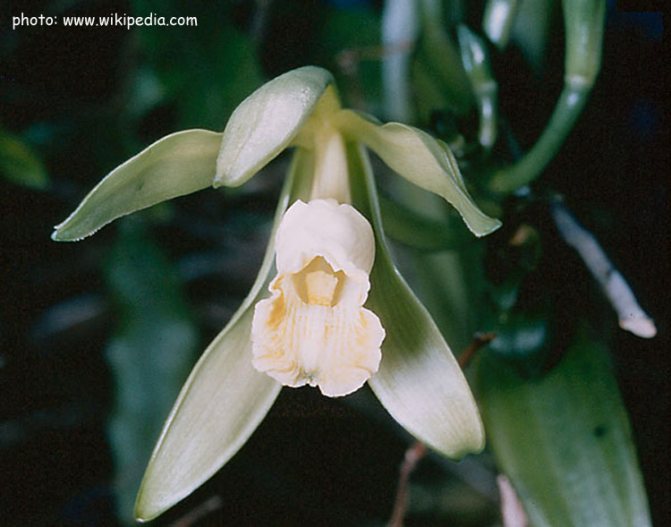

Vanilla flower
2. Lovely Mexican
What comes to mind when you say vanilla? Aroma. Aroma and taste are unique sensations that this spice gives to desserts: ice cream, creams, confectionery. The fragrance is the second, heart note of many world famous perfumes, which remains a trail for a long time after their use, gradually exciting with its unobtrusive unique charm. The aroma of vanilla is healing, it is used in aromatherapy, it relieves stress, relaxes, and evokes a feeling of tranquility. Experts in this field explain this by the fact that most people subconsciously associate the smell of vanilla with childhood, home, holiday food and happy memories.
The smell of vanilla involuntarily transports us to the hot noon of the tropical forest - so let's follow it.
Vanilla (Vanilla) is a genus of plants of the Orchid family (Orchidaceae), consisting of 110 species. However, only two species, Vanilla planifolia and Vanilla pompona and their hybrids, produce fruits from which the aromatic substance is obtained, the rest of the vanilla species are purely decorative.
The homeland of Vanilla planifolia, the main supplier of the favorite spice, is Mexico. The plant has been known in pre-Columbian America for centuries. When the Aztecs, expanding their possessions, conquered the Totonac tribe, they found that they were collecting the fruits of the amazing orchid growing in their forests, fruits that emit an unusually pleasant smell that can improve the taste of food and drink. The Aztecs named the plant "tlilxochitl", which means "black flowers," probably because the vanilla fruit turns brown-black when fully ripe and dry. The Aztecs began to take tribute from the Totonacs with vanilla fruits; they used it as an additive in chocolatl, a drink made from cocoa fruits (an article on cocoa fruits and chocolate can be read here). Vanilla was also used in folk medicine and in shamanic magical practices.
The ancient legend of the Totonac Indians about the origin of vanilla on earth has survived to this day.
..At the time when the leader of the Totonacs Tenizli the Third ruled, one of his wives gave birth to a girl who was named Tzakopontsitsa - the Morning Star. The girl was of such extraordinary beauty that the ambitious leader could not even imagine that he would be able to give her as a wife to a mere mortal, no matter how noble and good he was. Therefore, it was decided to dedicate the Morning Star to the powerful goddess Tonakayohua - the patroness of seeds, fruits and crops. The servants of this goddess, on whom so much depended for the well-fed and prosperous existence of the Totonacs, had to keep chastity from childhood and remain virgin all their lives.
The young son of the leader of a neighboring tribe, named Tskotan-ohga - Young Deer, having once seen the Morning Star in the temple, was blinded by her beauty and lost his head from the outbreak of love. He knew that for breaking the vows they had made, they would both face inevitable death, but he could not help himself. Once, when the girl left the temple and once again went to collect flowers to decorate it, he kidnapped her and fled with her to the rainforest. At first, the girl did not understand what the handsome young man wanted from her, but soon she became imbued with mutual feeling and willingly reciprocated. But as soon as they were about to cross the high mountain pass, beyond which freedom awaited them, the offended priests of the goddess Tonakayohua caught up with them. They grabbed the young lovers and cut off their heads.The priests took out the still quivering hearts and laid them on the altar of the formidable goddess so that she would not be very angry with the apostate, and the bodies, as unnecessary, were thrown into a deep crevice.
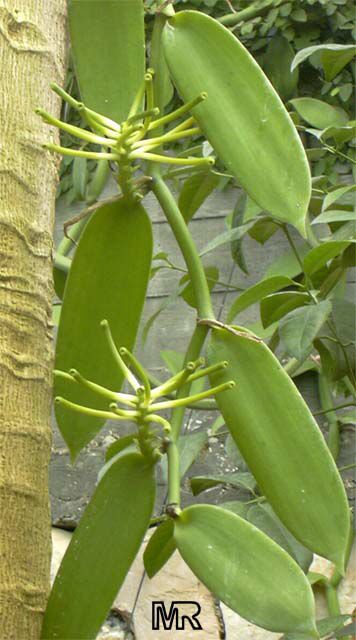

Vanilla planifolia leaves and young pods
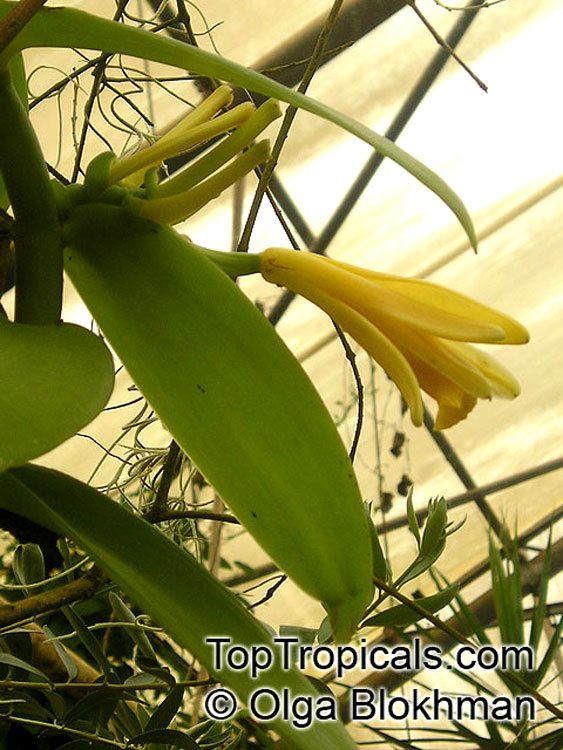

Some time later, the grass began to dry on the spot where the blood of the Young Deer and the Morning Star had been shed. Then an unknown shrub began to grow on it with fantastic speed. In a few days it reached the height of a human being and was covered with dense foliage. Soon a graceful flexible liana grew up next to the bush, which moved touchingly around its branches. The plants looked like gentle lovers in an embrace. Everyone watched this phenomenon in amazement, and one morning, flowers appeared on the vine, similar to a young woman dreaming of a lover. After they faded and dried up, thin graceful pods appeared in their place. The flowers and fruits emanated an incomparable aroma that the finest incense from the Tonakayohua Temple could not match. The priests realized that the blood of the young novice and her lover was reborn into a powerful dense bush and a delicate orchid. Both plants were considered sacred. The Totonaks began to call him caxixanath, and since then they have brought it as a gift to the powerful goddess Tonakayohua - the patroness of seeds, fruits and crops ..
After the conquest of South and Central America by the Spanish conquistadors, in 1520, vanilla fruits, along with cocoa, were brought to Europe. For a long time, this spice was used here only as an additive in cocoa, then they began to flavor smoking and chewing tobacco with it, and much later they began to use it in cooking.
Vanilla owes its name to the famous French botanist Charles Plumier (1646-1704), it was officially recorded in 1754, after the death of the scientist. The root of the name comes from the Spanish word "vaina" - vagina - derived from the Latin word "vagina". Most likely, the structure and shape of the vanilla flower caused such an association in the botanist. But more on that later.
Vanilla planifolia is a climbing liana that needs support, natural (tree) or artificial (pillar). In nature, liana can reach 35 meters in height, but usually when grown on plantations, it is cut at the height of human growth. Besides convenience, this pruning stimulates increased flowering. Vanilla can grow without support, but in this case it grows very small and gives only a few flowers.
Along the entire length of a rather thin flexible stem, oblong-oval, thick, leathery, dark green leaves are located. Long and strong aerial roots growing from each leaf node hold firmly to the support. The inflorescences are collected in a brush and consist of large, pale, yellow-green flowers attached to the axil of the leaf on short pedicels. If the plant is not cut, sometimes at the height of flowering, their total number reaches one hundred, but usually the number does not exceed twenty or thirty. Vanilla flowers have a delicate and sweet scent that has brought this plant worldwide fame.
3. Almost like a real woman ..
So the flowers bloomed. Their age is short, they live only one day, during which they need to manage not only to please the world with their beauty, but also to fulfill the main purpose of nature - to tie future fruits. Vanilla is bisexual, it has both an anther stamen and a pistil filled with sweet fragrant nectar. However, the complex design of the flower makes pollination difficult, which is not an easy task in vanilla. Here is a diagram showing a cutaway vanilla flower:


The perianth consists of five oblong petals, the sixth, forming a lip, is rolled into a tube, in which a pistil and one stamen are hidden. The anther is located above the stigma of the pistil, but they are separated by rostellum - a mobile membrane that interferes with natural pollination.Therefore, a plant cannot do without the help of a pollinator insect, which has to crawl under the rostellum, push it away, contributing to the adhesion of pollen to its surface lubricated with sticky nectar, so that then the adhering pollen will fall on the pistil. And everything would not be so difficult if it were not for the fact that the pollinator of vanilla is the stingless melipon bees (Meliponula ferruginea), which do not live anywhere except in Mexico. Sometimes, very rarely, their function can be performed by hummingbird crumbs, but these cases are so few in number that this practically does not affect the total number of pollinated flowers. That is why vanilla remained a Mexican endemic for more than three hundred years after its discovery by Europeans - attempts to relocate bees along with the plant to other regions were unsuccessful.
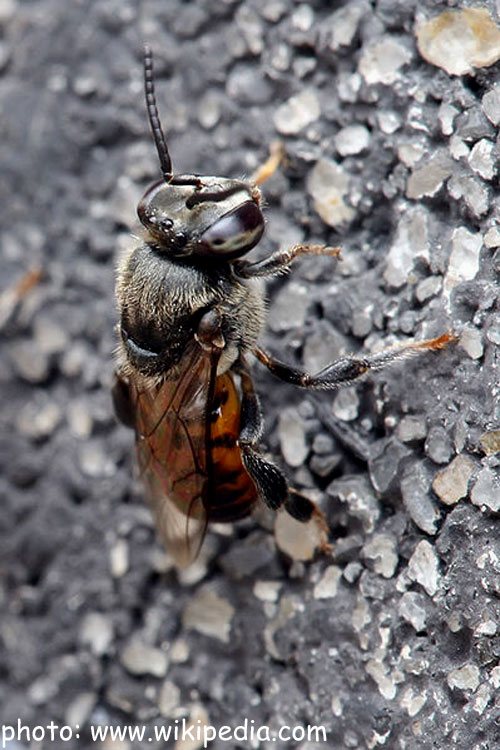

Bee Meliponula ferruginea
This continued until 1836, when one fine summer day, the Belgian botanist Charles Francois Antoine Morren (Charles Francois Antoine Morren, 1807-1858), drinking coffee on his patio in Veracruz (Mexico), did not pay attention to the little black bees, swirling around the vanilla flowers growing nearby. The scientist became interested and began to observe the manipulations that insects produced. They literally crawled into the core, trying to get nectar from the stigma of the pistil, while pushing back the membrane with their backs, allowing pollen to get from the anther to the pistil - it was carried by the bees themselves on their backs, and the rostellum membrane, abundantly covered with adhered pollen. A few hours later, the flower withered, and a few days later, Morren saw that a pod began to form in its place. Morren immediately set to work experimenting with hand-pollination of vanilla. A few years later, in 1841, a simple and effective method of artificial pollination of vanilla was developed by Edmond Albius, a 12-year-old boy from the plantations of Reunion Island. Until that time, vanilla was planted there only as an ornamental plant. This method has remained practically unchanged, it is successfully used today. It is extremely simple: with a cone-shaped bamboo chip, an agricultural worker pushes the membrane separating the anther from the stigma of the pistil, and then, using his thumb, transfers the pollen to the pistil. And that's all. The plant begins to form a fruit ovary! Of course, this work is very intensive and laborious - vanilla flowers are short-lived, and during the flowering period it is necessary to have time to check and pollinate as many flowers as possible daily.
Vanilla fruit ripens for a long time - nine months. It is a seed pod capsule; when fully ripe, it bursts at the outer end, and when it dries, its surface is covered with white crystals, which are derivatives of phenol. The pods appear to be sprinkled with diamond powder or covered with frost. It is these crystals that give vanilla its characteristic scent. The fruit contains tiny seeds that are odorless and tasteless. Often times, in dishes prepared using a whole pod of natural vanilla, you can see them as tiny black specks, reminiscent of ground pepper.
Now let's go back to the cutaway diagram of the flower, click on it to enlarge it and take a closer look. Doesn't it look like anything? Even if you are completely far from medicine, we all learned anatomy at school. Let us recall the internal structure of the female reproductive organs. Well, how much it looks like! Including the timing of gestation, the same as for a woman. No, it's not for nothing that Charles Plumier called vanilla vanilla, glorifying this fragrant and most beautiful of the women of the plant world, an orchid named Morning Star ..
4. The victorious march through the tropical islands
When the problem with pollination was solved, there was a real opportunity to grow vanilla to get fragrant pods in other regions.Very soon, from the island of Reunion, where the technology of artificial pollination was developed, vanilla spread to the neighboring Comoros and Madagascar. In the same place, in 1898, its commercial plantations were first established, producing up to 200 tons of pods per year. Madagascar is still the leader in sales of this spice - 97% of world production falls on its share. In general, vanilla, which arrives on store shelves these days, is divided into four types:
- Mexican vanilla, Vanilla planifolia, growing in its historical homeland, Mexico, is considered the highest quality and most expensive. However, if when visiting this country you want to acquire this local celebrity, do not buy it at the tourist markets - here they often sell its extract under the guise of natural vanilla, mixed with tonka bean extract containing the alkaloid coumarin. It is very difficult to distinguish this extract from natural vanilla extract by taste and smell, but coumarin is not safe for the liver. In the United States, for example, it is banned for use in food production;
- Bourbon vanilla or Madagascar vanilla is a few cultivars of Vanilla planifolia, it is the best quality vanilla with long pods 20-25 centimeters long. She is a direct descendant of Mexican vanilla, which was completely assimilated on the Indian Ocean islands (Madagascar, Comoros and Reunion). The former name of Reunion is Bourbon Island, hence the name - Bourbon vanilla;
- West Indian vanilla is a Vanilla pompona cultivar successfully grown in the Caribbean, Central and South America. She has shorter pods, and the quality is lower;
- Tahitian vanilla (Vanilla tahitiensis), native to the islands of French Polynesia, Tahiti and Niue, is a hybrid of Vanilla planifolia and Vanilla odorata. The appearance of flat-leaved vanilla in this so remote region is almost a round-the-world journey: the French admiral Francois Alphonse Hamelin (1796-1864) brought it to Polynesia from the Philippines, where it, in turn, was delivered on a trading galleon from Guatemala. Its fruits are reddish-brown in color, the length of the pods is 12-14 centimeters. However, the quality of this vanilla is considered to be the lowest.
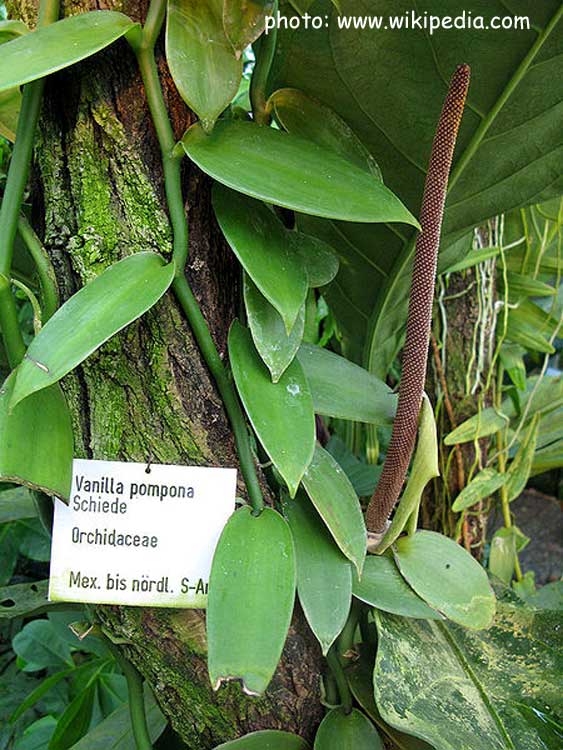

West Indian Vanilla pompona
The existing term "French vanilla" does not refer to the species or cultivars of this plant. It involves the use of a whole natural vanilla pod containing seeds in the preparation of a particular dish. The term originated from the French method of making ice cream based on custard, cream, egg yolks and flavoring it with whole vanilla pods. Also, French vanilla is sometimes referred to as a syrup consisting of cream, nuts, caramel or fudge and, of course, a large amount of vanilla.
5. A bit of technology
Getting fragrant pods is no less laborious than pollination. As already mentioned, the ripening process takes a long time, and immature, green pods cannot be harvested. Suitable for harvesting are pods that have a light yellow color and a small crack at the end. Even on one plant, the pods do not ripen at the same time, therefore, during the harvest season, you have to carry out a daily inspection and, literally one by one, manually pick the ripe fruits. Overripe fruits of a darker color, with obvious cracks, are considered low-grade raw materials. To determine the value of the pods, their size is also important - the longer the bean, the higher its quality. So, 15-centimeter or more pods are considered first-class, 10-15-centimeter - the second grade, well, and less than 10 centimeters - the third grade, substandard. Inside each pod there are many small black seeds that are covered with a dark red liquid from which the vanilla essence is extracted.
Growing vanilla requires constant care of the plant as a whole. It was found that the stimulation of aerial roots causes an increase in yield. A five-year-old liana is capable of producing from one and a half to three kilogram pods per season, in the future its yield increases to six kilograms. There are currently several techniques for harvesting vanilla, but they all contain four basic steps:


- To prevent further growth, the plant tissue of the pod must be killed. For this, there are various methods: placing in the direct rays of the tropical sun, placing in a hot oven, exposure to cold. The most common is to put the pods in hot water (63-65C) for a few minutes. This is enough to completely stop the vegetative growth of the pods and initiate the enzymatic reactions responsible for the formation of the aroma.
- Sweating is wrapping the pods in a woolen cloth and keeping them in high humidity conditions in direct sunlight (with a temperature of 45-60C) for one hour. The next day, the procedure is repeated, increasing the time spent in the sun by 10 minutes. This procedure is repeated for ten days, and every day the period of exposure to the sun is lengthened by 10 minutes. This process allows enzymes to catalyze reactions that produce the specific color, taste, and smell of vanilla. The pods begin to turn brown and have a spicy, bitter taste. Upon completion of the sweating process, the pods are placed in wooden air-tight boxes.
- Slow drying is essential to prevent decay and to retain the aroma. Most often, the pods are simply laid out in the sun in the morning and dried naturally until the evening. Drying is then continued indoors, laying the pods on wooden racks, where they spend three to four weeks, until a white crystalline bloom appears. Residual moisture should not exceed 25-30% (at 60-70% at the beginning of the procedure). This percentage of moisture indicates the completion of the processing of the pods and ensures the full disclosure of their aromatic qualities.
- Conditioning. But that's not all. To fully develop the aroma, the pods are kept in closed boxes for several months. Then the pods are sorted, classified, packaged, wrapped in waxed paper and stored under conditions that ensure the complete preservation of the quality of the product, especially its taste and smell.
High quality pods should be soft, elastic, slightly curled, oily to the touch, dark brown in color with small, faint white crystals on the surface. The pods contain the glycoside glucovanillin, essential oil, tannins. During fermentation that occurs during processing, glucovanillin is broken down into vanillin and glucose. The content of natural vanillin in such pods ranges from 0.75 to 2.9%, and sometimes even up to 12.5%. To meet the standard, its content must be at least 2.5%.
Real vanilla, properly prepared for use and storage, is striking in its persistence. There is a known case when, after 36 years of storage, vanilla retained all its properties.
The price of natural vanilla is high, it is the second most expensive spice after saffron, and this is natural, given the complexity of its production. However, in stores, you can usually buy cheap artificial vanillin or vanilla sugar. Currently, there are 171 types of vanilla fragrances, however, when conducting a comparative analysis, only one of them was found to contain vanillin of natural origin. Most of the synthesized vanillins are a by-product in the production of paper and rosin from pine chips, or from waste sulfate cellulose containing lignosulfonic acid.In recent years, vanillin synthesized from methyl and ethyl has begun to be used in the food industry. Ethyl vanillin has a stronger odor and is more expensive. The smell of artificial vanillins is devoid of the subtlety of real vanilla, but it is sharp and strong.
One of the culinary magazines in the United States, Cook's Illustrated, conducted a test to determine the taste and smell of ice cream, which vanillin was used in its preparation: artificial or natural. To the horror of the editors, none of the testers could tell one from the other! Here's an incident.
6. Botanical and other nuances
In natural conditions, the ideal terrain for growing vanilla is in regions located between 10 and 20 degrees above and below the equator. An altitude not exceeding 1500 meters above sea level, a hot and humid tropical climate with a moderate (150-300 cm) amount of rain falling regularly enough for 10 months - this is what this orchid likes. The optimum temperature should be around 30C during the day and at least 15-20C at night. At lower temperatures or insufficient humidity, vanilla can be grown in a greenhouse, where normal conditions for this plant are ensured by covering glass or foil walls and roofs with polymer mesh, which gives 50% shading, and the necessary humidity is achieved using an evaporator.
Vanilla prefers loose, loamy soil with a high content of organic matter. She needs good drainage, for which it is best to plant plants in an area with a slight natural slope. Mulching is very important for these vines, and the mulch should be renewed 3-4 times a year. The amount of dressings depends on the quality of the soil, but the main recommendations of experts are as follows: each plant should receive 40-60 g of nitrogen, 20-30 g of superphosphate and 60-100 g of potassium sulfate annually. Organic fertilizers such as vermicompost, cake, chicken manure and wood ash are also added. In addition to these fertilizers, which are applied under the roots of the plant, it is very useful to spray the leaves with a 1% solution of nitrogen-phosphorus-potassium in a ratio of 17:17:17 on a monthly basis.
Vanilla is usually propagated by stem cuttings, which are taken from the non-flowering part of the vine. Slightly wilted cuttings take root more easily and give stronger roots. For each shank, a groove is dug, the length of which depends on the length of the shank (optimally 60 cm), the depth is 45 cm. The shank is placed in grooves along the length and buried in. Coconut husk mulching and drip irrigation, as well as shading from direct sunlight, provide optimal conditions for good vegetative growth of planted cuttings, which take root very quickly. When the height of a young plant reaches 60-120 cm, it can be transplanted to a permanent place, in a garden or greenhouse. Saplings, the height of which is less than 60 cm, need additional care, since their roots are not yet strong enough.
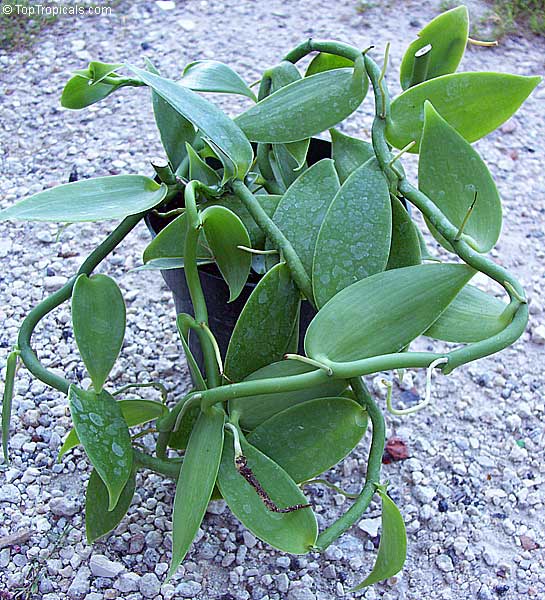

Young vanilla in a pot
Vanilla goes on sale in the form of whole pods, ground (ground pods are sometimes mixed with sugar, starch or other ingredients) and in the form of an extract, which is a 35% alcoholic solution of essence squeezed from the near-seed liquid of vanilla pods.


Vanilla variegata
Vanilla is practically the most subtle spice used in cooking. It is added to all kinds of sweet dishes: jams, cookies, pastries, cakes, muffins, gingerbread, sweet pies, puddings, curd products, creams, jelly, compotes, mousses, dessert fruit dishes, sweet fruit and milk soups, sauces and jellies ... Vanilla is the main flavor of ice cream, most people consider it the main, base smell of this delicacy. Added to cocoa and coffee, which have their own unique smell, vanilla, mixing with them, enhances their smell and allows you to get a new original combination, giving a unique charm to these products.
As already mentioned, vanilla is widely used in perfumery, cosmetics and aromatherapy.
Fragrant spice and medicine have not been spared. In ancient medical treatises, she was credited with anti-inflammatory and aphrodisiac properties. It was believed to cure male impotence and female coldness, and was also an antidote to many poisons.
However, modern medicine has found much more interesting qualities in it. Its ability to increase the level of catecholamines, including adrenaline, has been noted, which has allowed it to be classified as a mild stimulant that can, however, be mildly addictive. In in-vitro tests, vanilla has shown itself to be a substance that can block some of the functions of remote microbial interactions, such as, for example, virulence - the ability of a microorganism to cause a particular disease. This caused an increased interest of scientists in her, since bacteria become virulent only when a signal is received that their number has become enough to resist the body's immune system. Thus, vanilla, by blocking such a signal, has the potential to prevent microbial attack on the body.
Among esotericists, vanilla is considered a plant belonging to the element of fire, its aura is warm. Inhalation of vanilla oil vapors has a stimulating effect on women, therefore it is one of the magical components used in various love rituals.
What can be added to the above? Perhaps the words of the American journalist Teresa Howard, who wrote in her article published in USA TODAY magazine:
“.. Marketers say that in difficult times, customers need a product that can give them a sense of comfort. And what makes you feel safe more than the taste and smell of vanilla? .. "
This article is called: Vanilla: know it, eat it, drink it, love it! So let's love her. Now more consciously.
Description of the vanilla plant: what the fruit looks like (with photo)
The description of vanilla can begin with the fact that the life form of this unique orchid - the only orchid of such great importance in medicine and especially in the food industry - is liana. More precisely, a herbaceous vine with rather long stems climbing trees, which give rise to numerous aerial roots that absorb moisture from the tropical air saturated with water vapor.
Look at the vanilla orchid in the photo, which shows the main forms of the plant:
The succulent leaves of the vanilla plant have the shape of an elongated ellipse and arched venation.
Irregular yellowish-green flowers in clusters.
The perianth is composed of five oblong leaves; the sixth leaflet, forming the so-called lip, is rolled up into a tube and contains one stamen and a pistil. Such an arrangement makes pollination extremely difficult, therefore at home it - pollination - is carried out by certain species of Lepidoptera (butterflies), and when grown in culture, artificial pollination with a brush is practiced. The inferior ovary forms a narrow, long fruit upon completion of development.
What vanilla looks like can be seen in the numerous illustrations accompanying this material:
Freshly picked vanilla fruits contain the completely odorless glycoside glucovanillin. But during subsequent fermentation, it breaks down into glucose and the free aldehyde vanillin, which is precisely the carrier of a very pleasant aroma. The presence of anise alcohol, cinnamon esters and other aromatic substances in the essential oil makes the smell of vanilla even more pleasant. Vanilla as a plant is a parasitic form.
Vanilla fruits - juicy capsules - are harvested in an immature state, then subjecting them to long ripening, fermentation, and drying.
The resulting raw material - narrow and long dark brown wrinkled boxes, which gave the world the universally known name of "vanilla sticks" - has the very familiar characteristic smell, the carrier of which is vanillin, the excess of which is released on the surface of the boxes in the form of colorless crystals.
There are two botanical types of vanilla that are cultivated for spice production:
Vanilla planifolia
Vanilla pompona
The first produces several cultivars of better quality vanilla, with 20–25 cm long pods, the second produces short, lower quality pods.
Look at the vanilla plant in the photo, which shows separately the parts of the orchid and the fruits:
Mexico and Central America are considered the homeland. This spice is cultivated in many countries of the Caribbean (Jamaica, Haiti, Guadeloupe, Martinique), in the tropical part of South America (especially in Guiana), in Ceylon, in Malaysia, in Madagascar, Reunion, Seychelles, Comoros, on the island of Mauritius and in Polynesia - Tahiti and Hawaii. The main production of vanilla is currently concentrated on the islands of Reunion and Madagascar (50% of world production).
Where does it grow?
If originally vanilla grew only in some regions of Central America, today it is grown in many countries of the tropical zone. For normal growth and development, this plant needs a humid and hot climate. At the same time, plants need a temperature not higher than + 300C and not lower than + 150C, and a moisture content of about 80% is desirable. All types of vanilla are quite demanding on the soil: it should be loose and enriched with organic substances, it should be good for air and water.
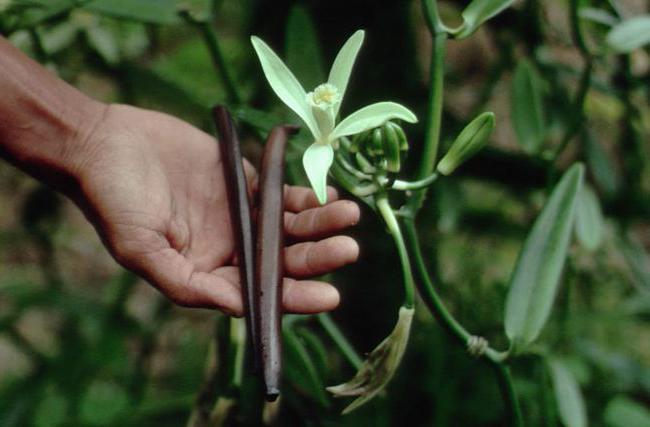

Today, vanilla is cultivated in many countries located in regions from 10 to 20 degrees from the equator: in Mexico, Brazil, Paraguay, the USA, the states of West Africa and on the islands of French Polynesia.
Breeding
I first wanted to grow an orchid from seeds I got from a vanilla pod I bought from a store. But the gardeners I know told me that to get seedlings you need a special florarium with a certain microclimate. And the seeds that are contained in the pods that have undergone heat treatment are not at all viable. It is much easier to plant a vanilla orchid using the cuttings method. And then, having written off with one woman-flower grower, who has an adult liana of a vanilla orchid, I bought a stalk in a pot from her.
Selection and storage of spices
To choose a high-quality spice with a rich aroma, pay attention to some of the nuances:
- The stick is oily, plastic to the touch.
- Intense dark brown to black color. A bright characteristic odor should be present.
- Brittle, dry, cracked, light sticks should not be taken. Most likely, due to improper storage, they have lost their useful properties.
To help the pods retain their pleasant aroma for a long time, keep the sticks in a cool, dark place in a sealed jar.
Appearance and photos
Vanilla Orchid Appearance:
- length 10-30 meters;
- aerial roots along the liana, which attach it to the tree;
- large flowers of yellow or greenish color;
- dark green, fleshy and elongated leaves (some species have light stripes on the leaves).
Below are photos of a vanilla orchid.
The main varieties of vanilla
Information about varieties is presented in the plate:
| Variety | Features of the | Where is applied |
| Madagascar | This variety is considered the best. The pods are oily, long, the aroma is delicate, delicate. | In cooking and perfumery |
| Tahitian | The aroma is floral, fruity and tobacco notes are present. | In cooking (this spice is added to confectionery) and perfumery |
| Guadalupe | The quality is lower, the aroma is rough, the taste is harsh. | In perfumery, as well as for flavoring tobacco products. Not used in cooking. |


Products
The following spice derivatives are commercially available:
- essence.A type of alcoholic solution that contains vanilla flavor. Store essences should read "natural vanilla flavor" on the label;


- extract. An alcoholic solution that is infused on the crushed fruits of vanilla pods;
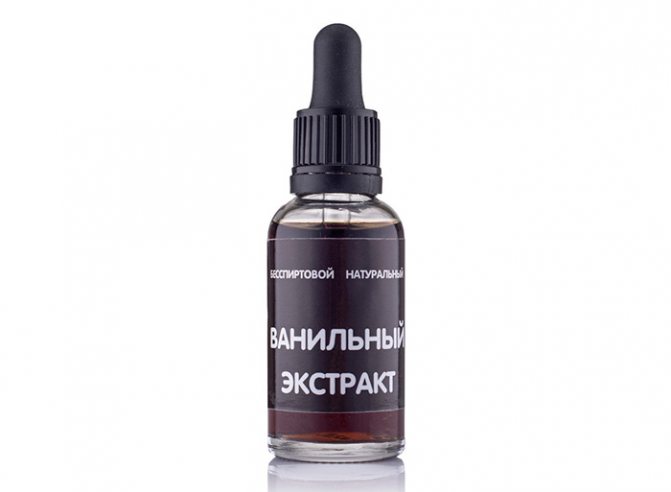

- sugar. It is a white aromatic powder. It consists of granulated sugar and crystalline vanillin.


Content
- 1. Growth 1.1. Climate in natural habitats
- 2.1. Plant size and type
- 3.1. Temperature
How to propagate?
The easiest and most affordable way to propagate is by cuttings.
Rooting procedure for cuttings:
- A part of the stem is cut off 30 - 35 cm.
- At the bottom of the cutting, all the leaves are cut off.
- The stalk is buried in the finished moist substrate.
- A support is installed to support the seedling.
- The container can be covered with cling film.
- The greenhouse is ventilated every day.
- The containers are stowed away in a shaded area.
- The temperature of the content is 25 ° C.
- The soil is regularly moistened.
- Rooting takes place within 4 weeks.
- The film is removed.
Important! Before root formation, the seedling grows slowly. After the stalk grows roots, the flower quickly grows.
We suggest you watch a video about vanilla orchid cuttings:
Growth:
Mexico, Caribbean, Costa Rica, Guatemala and Central America. The original habitat of the plant was, most likely, evergreen rainforests in eastern Mexico, as well as Guatemala, Belize and Honduras.
In Guatemala the orchid grows in swamps, in savannas, in mixed forests at altitudes from 0 m to 600 m above sea level.
In Mexico wild-growing flat-leaved vanilla is endangered, there are only 30 specimens of this species left.
In Belize the plant lives at an altitude of 750 m. In Costa Rica this orchid is found at altitudes from 2 m. to 900 m., and in Nicaragua in the vicinity of the San Juan River at an altitude of 200 m. In the Peruvian forests of the Amazon, Vanilla grows in the Imas and Loreto regions at heights of 185–240 m, and in Venezuela in the provinces of Bolivar, Cohedes, Miranda and Tachira at altitudes up to 400 m.
Climate in natural habitats:
- Fixed temperature range from + 16 ° C to + 36 ° C.
- Average humidity is over 80% throughout the year.
- Precipitation from 71 mm. in March up to 170 mm. in spring, summer and autumn.
- Average temperatures (day / night) + 28 ° C / + 21 ° C all year round.
External characteristics
Height of an adult plant
In vivo Vanilla vines reach 15-30 meters in length. Aerial roots are formed along the entire length of the stem. They hold the plant tightly to the bark of the tree.
It is the long vines and require special care for industrial planting on plantations.
The most commonly used methods at home:
- Installation of supports. Various options with pipes. They are covered with coconut fiber and moss. You can also come up with original supports (arches) yourself;
- Planting in hanging pots.
Number of leaves
- How many leaves on a particular plant will have to take a long time. Even with pets. This is not a phalaenopsis, which has 3-6 leaves;
- The vanilla orchid has them grow on a liana every 10-15 cm;
- Solid green and with light stripes. Oval.
Maximum peduncle length
- Peduncles short with racemose inflorescence... They can emerge from the axils of numerous leaves;
- Peduncles lots of... One grows 8-10 flowers. In artificial conditions, there are fewer of them (3-5 flowers).
Flower diameter and shape
- Yellow flowers with a distinct greenish tinge... There are also white and green;
- On average, they are 6-7 cm in diameter.But there is also about 10 cm;
- Blooms in spring and early summer;
- An elongated yellow tubular lip with a white edging is noteworthy.
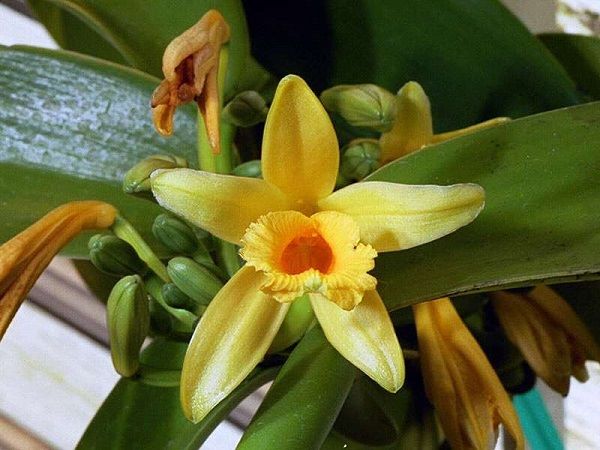

Vanilla orchid flower.





